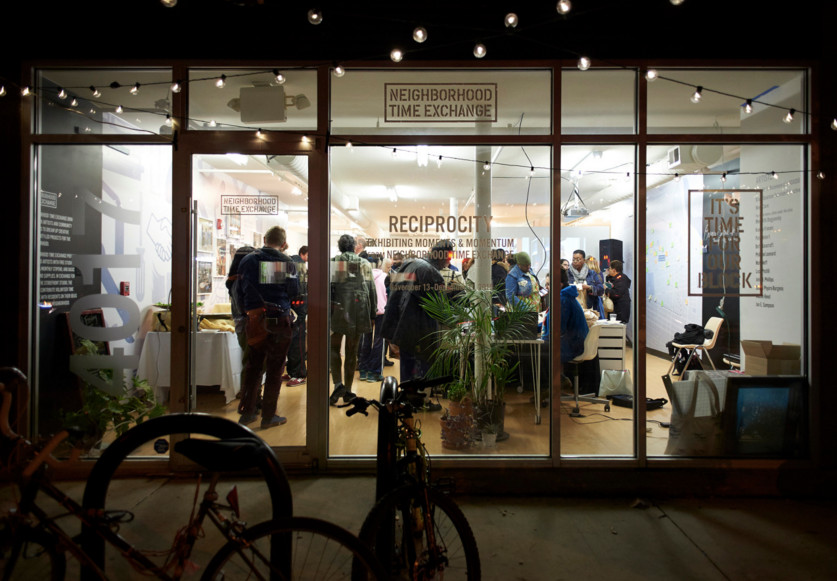On a single block in Mantua sat half a dozen vacant homes, their fronts covered with rotting plywood. One resident, the block captain, had had enough. Maybe nothing could be done about the vacant houses, sure, but did they have to be such a depressing eyesore that attracted squatters? He walked into a brightly lit storefront on Lancaster Avenue bearing the name Neighborhood Time Exchange, wrote down the problem on a small slip of paper, thumb-tacked it to a wall and walked out. Soon after, a group of artists showed up on his block with huge pieces of new plywood, painted a bright blue overlaid with a purple and orange geometric design. Together, artists and residents installed the vibrant panels, turning the moribund homes into pop-up murals.
Neighborhood Time Exchange is not a gang of fix-it artists—at least not totally. It is, instead, an artist residency program, but of a particular kind: Artists are given studio space and a stipend to work on their own art, with the condition that for every hour they spend on their own work they spend an hour working on projects in the community, suggested by community members. It is a twist on what the Mural Arts Program—one of Neighborhood Time Exchange’s organizers—usually does with public collaboration: Rather than seeking neighborhood input on a mural an artist was slated to design, the Exchange sought input on the type of project the artist would create.
“Residents of the Mantua, Saunders Park, West Powelton, Belmont and Mill Creek neighborhoods are encouraged to stop by our studio during open hours to submit a service request form for improving your community,” reads a flyer for the program. “From fix-ups to clean-ups, youth workshops to helping seniors—no project is too small!”
Neighborhood Time Exchange is a collaboration between Mural Arts, the City of Philadelphia, Broken City Lab (of Canada) and the People’s Emergency Center, which owns the storefront building that houses the project on the border of many high-needs neighborhoods. It opened its doors in January 2015, and requests started pouring in, says Dave Kyu, program coordinator. By the time NTE closes at the end of the year, artists will have completed 24 community projects.
“Artists,” says Kyu, “can really play an integral role in changing a neighborhood.”
Four artists were in residence at any given time, for three months each. They were selected through a competitive application process that asked such questions as “What does exchange mean to you?” One artist, Pato Hebert’s artist statement, countered with a series of his own questions: “When are we comfortable in our own skin? What makes us feel like aliens? What do we define as ours, sacred, everyday, untouched? Who and what are excluded by these delineations? How might we connect with all that is around us?”
Half the artists are from the Philadelphia area, half from places around the globe. They completed an average of three community projects during their residency, and agreed to show a sampling of their own work at the end of their stay. All of these guidelines for the residency were developed with input from a Neighborhood Advisory Council.
As expected, artists did visual projects like beautifying the vacant homes and painting a mural with the slogan “Respect Your Block” for the community association Women of Belmont, who organized a clean up and weeding of a vacant lot to make it worthy of the facelift. But NTE artists offered other skills too. Residents asked for help with legal problems or resume building, and many artists were able to use skills gleaned from previous careers, side jobs, or their own educations. At the end of each week, the artists-in-residence would meet to review the requests and match themselves with projects for which they would be well suited.
It is a twist on what the Mural Arts Program usually does with public collaboration: Rather than seeking neighborhood input on a mural an artist was slated to design, the Exchange sought input on the type of project the artist would create.
One of NTE’s overarching goals was to create authentic exchanges that would be deeply gratifying and useful to both parties involved. One artist took photos and put together a calendar for the St. Ignatius Nursing Home to raise money for its services. Another artist worked with a community group who wanted a banner to celebrate the 50th anniversary of Martin Luther King Jr. speaking at 40th and Lancaster.
Another artist offered a ‘zine class, a film class, and a soccer class at Martha Jefferson Elementary. As part of the film class, the artist worked with the students to write and produce a play called “More than Martin,” highlighting the contributions of other Civil Rights leaders, which they developed into a brochure the school can use to highlight its arts programs.
Although Neighborhood Time Exchange closes its doors at the end of the year, Cari Bender, a spokesperson for the Mural Arts program, says the lessons of the program will carry on in other projects, in other parts of the city. “Mural Arts is taking a lot of the learning from that model and seeing if they can apply it in many different ways,” she says “We are exploring some other projects for 2016 that will take pieces of it and see if they can put the wisdom and lessons learned into practice again.”
Among those lessons are the joy of collaboration, the ways art can provide tangible and useful outcomes, and what both neighborhood residents and participating artists gleaned from having a community of outward-looking artists in their midst.
“Artists,” says Kyu, “can really play an integral role in changing a neighborhood.”
Header photo: Albert Yee



